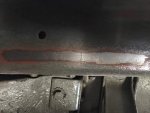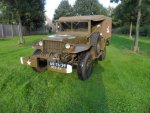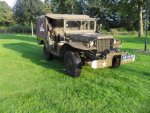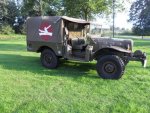Hi there,
thank you so much for your answer. I also thought it would be a Canadian T236, however my serial number doesn't fall in the range you qouted, instead it's about 42,000 before the first number 91,119,585. Therefor I wonder if it really is a Canadian T236. It also looks like it has a WC51 grille, but it has a winch like the WC52 has. So it could be someone restored it with the wrong grille though. It also has a wide body.
View attachment 520873 View attachment 520874View attachment 520875View attachment 520876
Although this is an old post, I'll take a chance by replying to it. I can't help you about what your Dodge truck is either a WC 51, WC52, or a Canadian variant, but I had to comment on the 84th Infantry Division (US) patch that has been painted on the canvas. Did you do that, and if so, why? The reason I am curious is that I was assigned to a sub unit of the 84th Division after the war when it was an Army Reserve formation. The headquarters used to be in Milwaukee, WI located on an old NIKE missile base. The period of time that I was assigned to this division was not that long 1974 to 1987 and the unit I was assigned to has been inactivated. The Division itself has been moved to FT Knox, KY and has changed missions since my day and I wouldn't recognize it now.
The 84th Division arrived in the ETO on 20 September 1944 and had 170 days of combat.It returned to the US on 19 January 1946 and was inactivated and assigned to the Reserve two days later on 21 January 1946.
Its record in WW II is outstanding. The 84th Infantry Division arrived in England, 1 October 1944, and trained. It landed on Omaha Beach, 1-4 November 1944, and moved to the vicinity of Gulpen, Holland, 5-12 November. The Division entered combat, 18 November, with an attack on Geilenkirchen, Germany, as part of the larger offensive in the Roer Valley, north of Aachen. Taking Geilenkirchen, 19 November, the Division pushed forward to take Beeck and Lindern in the face of heavy enemy resistance, 29 November. After a short rest, the Division returned to the fight, taking Wurm and Mullendorf, 18 December, before moving to Belgium to help stem the German winter offensive. Battling in snow, sleet, and rain, the Division threw off German attacks, recaptured Verdenne, 24-28 December, took Beffe and Devantave, 4-6 January 1945, and seized Laroche, 11 January. By 16 January, the Bulge had been reduced. After a 5-day respite, the 84th resumed the offensive, taking Gouvy and Beho. On 7 February, the Division assumed responsibility for the Roer River zone, between Linnich and Himmerich, and trained for the river crossing. On 23 February 1945, the Division cut across the Roer, took Boisheim and Dulken, 1 March, crossed the Niers Canal on the 2d, took Krefeld, 3 March, and reached the Rhine by 5 March. The Division trained along the west bank of the river in March. After crossing the Rhine, 1 April, the Division drove from Lembeck toward Bielefeld in conjunction with the 5th Armored Division, crossing the Weser River to capture Hanover, 10 April. By 13 April, the Division had reached the Elbe, and halted its advance, patrolling along the river. The Russians were contacted at Balow, 2 May 1945. The Division remained on occupation duty in Germany after VE Day, returning to the United States in January 1946 for demobilization.









